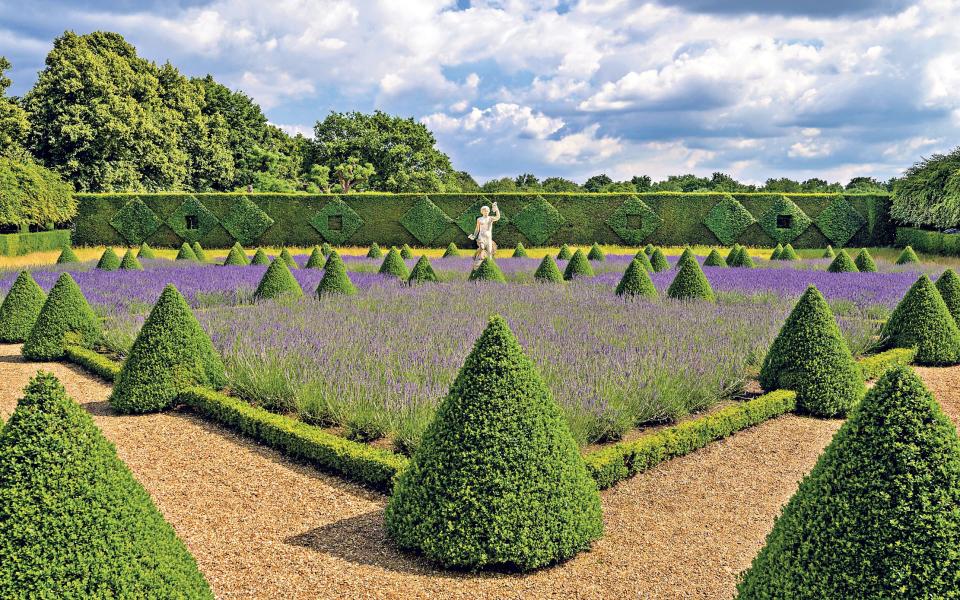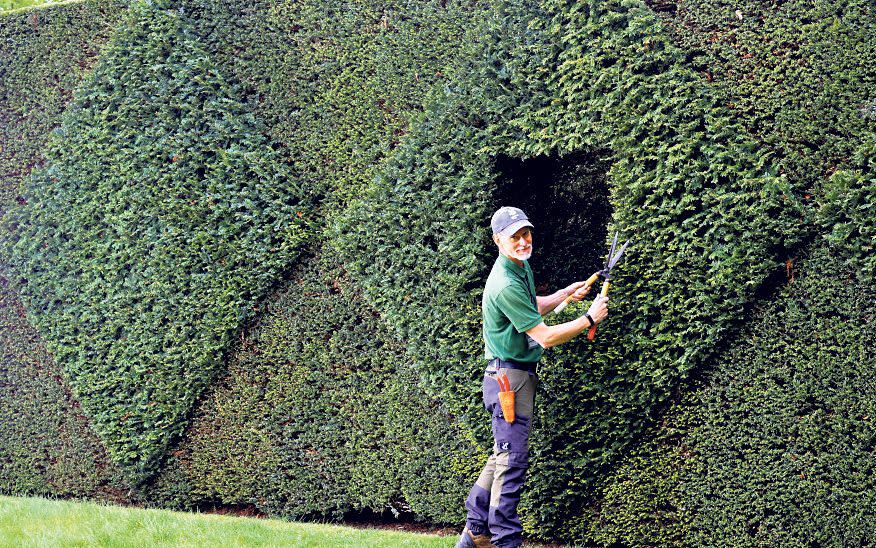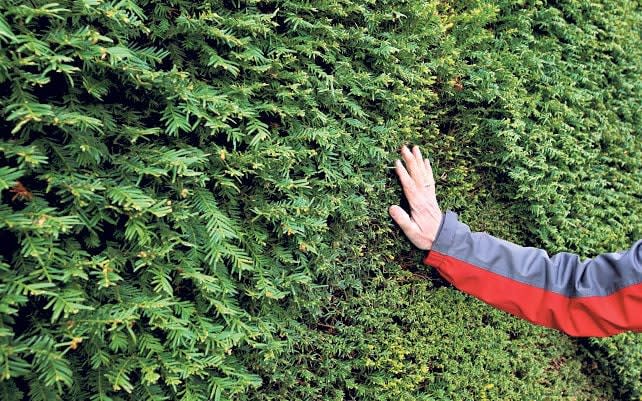How topiary got cool again

‘The process of creating and clipping topiary is all-involving. It demands focus on what you’re doing, without your mind wandering and worrying about the way the world is going,” says Chris Poole, a volunteer gardener at Ham House and Garden, who has been involved in fashioning remarkable new topiary designs. “At the end of it, you’ve got something beautiful, which is incredibly rewarding. It’s the same as painting or sculpting. Your material is a plant, and your tools are shears and snips.”
In the formal gardens of the 17th-century house on the banks of the River Thames near Richmond, visitors to the Cherry Garden marvel at Poole’s topiary diamonds. The geometry echoes that of four diamond-shaped flower beds in the garden, and of the diamond-chequered black and white marble floor of Ham House’s main hall, dating back to 1610. The designs are entirely novel, but chime with the heritage of the place.
“We left long growth in the hedge for a year, and then cut around the excess growth to develop protruding diamond shapes, instead of cutting it all back flat. Before clipping, we used spray paint to demarcate where we wanted the points of each diamond to sit. The effect is that of a relief, a wall-mounted sculpture in which the three-dimensional elements are raised from a flat base.
“We’re trying to recreate the ornamental wow factor that 17th-century visitors to the garden would have experienced as they promenaded. People came here to be impressed by the gardens, and we hope our modern day visitors will continue to be impressed.”
This isn’t the first time Ham House and Gardens has set out to impress anew in recent years. In 2019, former head gardener Rosie Fyles (now head of gardens at Chiswick House and Gardens) planted a summer meadow of 500,000 spring bulbs in scroll-shaped patterns, echoing the shapes of the 17th-century furniture in the house.

The topiary designs were partly the brainchild of Poole’s colleague, staff gardener Christina Moreton. “We wanted to add a new dimension to what was a pretty boring yew hedge with just a couple of windows in it looking through,” Poole explains. “I was partly inspired by a garden visit to the Badminton Estate in Gloucestershire, where I’d seen a topiary relief of a three-dimensional dog cut into a hedge by the swimming pool. It had sat in the back of my mind.
“Rosie Fyles and I had also visited Cadenham Manor’s gardens in Wiltshire, where they’ve clipped striking column reliefs into the hedges that divide the garden rooms.”
Poole knows his onions. As former chairman of the European Boxwood and Topiary Society, he has worked to inform the gardening world how to manage the destructive box tree caterpillar on box topiary (methods include attracting jackdaws, a natural predator). More than anything, Poole’s wish is to share his appreciation for topiary, and to introduce would-be topiarists to the wonderful world of shaping plants for visual effect.
“I’ve worked with the best topiarists in the country, such as James Crebbin-Bailey [who won Gold medals at the RHS Chelsea Flower Show in 2011 and 2012], James Todman and Charlotte Molesworth, and I’ve absorbed their enthusiasm,” says Poole.
“Creating topiary with attention to line and form doesn’t have to be old-fashioned or about stuffy spirals and balls in large, grand gardens. Topiary is often associated with manor houses, but we want to inspire everyday gardeners. Visitors to Ham House often ask how we created the reliefs. We’re at pains to tell them that anyone can ‘topiarise’ in an ordinary front or back garden, whether on a privet hedge at the front of a terraced house or a small lemon cypress on a balcony.
“Topiary is possible on any scale, and gives you a piece of living art to tend to. If you don’t like it, you can clip it all off and it will grow back again.”
With the aim of encouraging the nation to “topiarise”, Poole has been running “learn to clip” topiary gardening courses with the likes of topiary artist Darren Lerigo of Modern Mint, who learnt his craft under the tutelage of Jake Hobson. (In the topiary world, Hobson is a bit of a rock star. He attended the Slade School of Art before discovering Japanese “cloud pruning” techniques, and has been described as “a sculptor who just happens to use living trees and shrubs as his medium”.)
“We want to make topiary more inclusive, and get more people doing it and enjoying it. The possibilities are endless,” emphasises Poole. “I’ve seen 18-year-olds clipping things like Harry Potter-inspired golden snitches. It doesn’t have to be the same all the time.”
Poole’s latest topiary experiment is the establishment of a William Hogarth-inspired “line of beauty” relief topiary on the other side of the hedge. “There’s a path between it and another yew which we wanted to make more enticing,” he says.

Hogarth’s line of beauty is an S-shaped curved line, pleasing for the aesthete’s eye to follow. “The eye has this sort of enjoyment in winding walks, and serpentine rivers,” he wrote, in praise of forms composed of waving, “serpentine” lines. “Hogarth defined the line of beauty in The Analysis of Beauty in 1753, after Ham House was built, but the idea is that it will draw the eye and make you want to walk down the path,” says Poole.
“The wonder of topiary is that it’s ornamental and gives fixed points and shapes to a garden, regardless of the time of year. Around it, the garden changes continuously, but topiary holds the structure together.”
Typically, box (Buxus sempervirens) and yew (Taxus baccata) are used for topiary, but Poole explains that pretty much any plant that regrows can be shaped – such as holly, ivy, laurel, privet, or larger rosemary, cypress and lavender.
“The Cherry Garden is made up of yew, box, holly and lavender,” he says. “Every September, we cut the lavender back into half-domes which burst forth into bee-covered mounds in the summer. When they wave in the breeze, it introduces movement, which you don’t get with box and yew topiary. There’s also hornbeam shaped into arches – yet another topiary element.”
For Poole, World Topiary Day on May 12 is “a terrific way to bring to the attention of the public an art form which has existed for thousands of years”. The hope is to introduce it to a new audience with new ideas, and to show off magnificent topiary in gardens big and small up and down the country. “It’s just about saying: look, there are so many wonderful things you can do – give it a go.”
For further information, visit nationaltrust.org.uk/ham-house-and-garden

